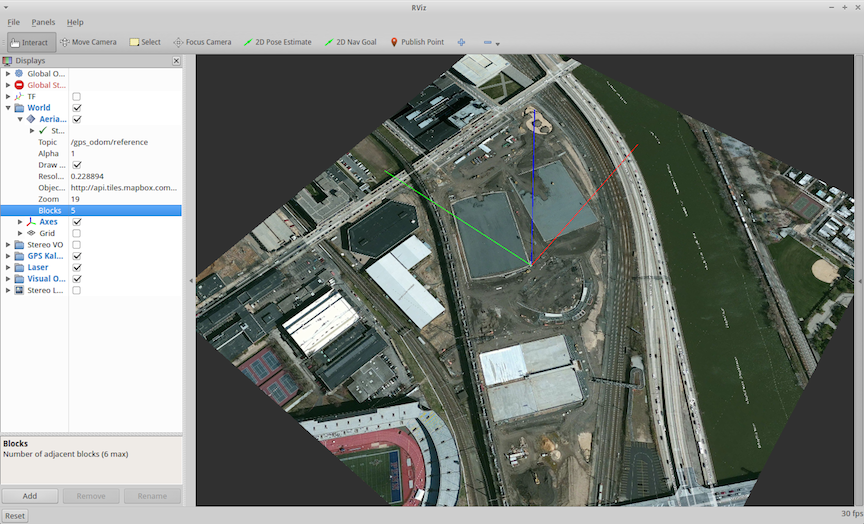Plugin for rviz for displaying satellite maps loaded from the internet.
In the near future this plugin will not add support for ROS 2. For an unofficial ROS 2 fork see blacksoul000/rviz_satellite.
In order to use rviz_satellite, add this package to your catkin workspace.
The package contains a launch file for demonstration purposes. Use it to verify your installation and to get started:
roslaunch rviz_satellite demo.launch
The launch file will fake a GPS position in Philadelphia, USA and display Wikimedia Maps nearby.
You can edit the longitude and latitude values in launch/demo.gps to change the position.
Check the Usage section below to learn how to use the position of your robot and a satellite map.
See demo file launch/demo_utm.launch for an example of using this plugin in the UTM frame mode (see below).
Add an instance of AerialMapDisplay to your rviz config.
The Topic field must point to a publisher of sensor_msgs/NavSatFix.
Map tiles will be cached to $HOME/.cache/rviz_satellite.
At present the cache does not expire automatically - you should delete the files in the folder if you want the images to be reloaded.
Currently, we only support the OpenStreetMap convention for tile URLs. This e.g. implies that only raster tiles (no vector tiles) are supported.
Transformation of tiles to RViz fixed frame can be done in two ways that are configured using Map Transform Type option:
- Specify a
Map frame, which is an ENU-oriented frame in which your robot localizes. This mode expects that the frame of the subscribedNavSatFixmessages is consistent with the measured latitude/longitude in this map frame. In this mode, the tiles go through an intermediate transform to the map frame. - Specify
UTM frame(and possiblyUTM zone). In this mode, no map frame is required and the tiles are directly placed on their UTM positions. This mode expects UTM frame is represented in your transform tree. The subscribedNavSatFixmessages are only used to determine the tiles to download, so small inconsistencies between theNavSatFixframe and the measured latitude/longitude is not a big problem. In this mode, you can also change the XY and Z position references from theNavSatFixmessage to a TF frame. This means the point around which the tiles are displayed is determined by UTM pose of the specified frame instead of theNavSatFixmessages.
You must provide a tile URL (Object URI) from which the satellite images are loaded.
The URL should have the form http://server.tld/{z}/{x}/{y}.jpg.
Where the tokens {z}, {x}, {y} represent the zoom level, x coordinate, and y coordinate respectively.
These will automatically be substituted by rviz_satellite when making HTTP requests.
rviz_satellite doesn't come with any preconfigured tile URL. For example, you could use one of the following tile servers:
- OpenStreetMap: https://tile.openstreetmap.org/{z}/{x}/{y}.png
- TomTom: https://api.tomtom.com/map/1/tile/basic/main/{z}/{x}/{y}.png?tileSize=512&key=[TOKEN]
- Mapbox: https://api.mapbox.com/styles/v1/mapbox/satellite-v9/tiles/256/{z}/{x}/{y}?access_token=[TOKEN]
For some of these, you have to request an access token first. Please refer to the respective terms of service and copyrights.
Topicis the topic of the GPS measurements.Map Transform Typeselects between theMap framemode andUTM framemode (see sectionUsage).Alphais simply the display transparency.Draw Underwill cause the map to be displayed below all other geometry.Zoomis the zoom level of the map. Recommended values are 16-19, as anything smaller is very low resolution. 22 is the current max.Blocksnumber of adjacent blocks to load. rviz_satellite will load the central block, and this many blocks around the center. 8 is the current max.Z Offsetspecifies offset of the displayed tiles in the Z coordinate from their default pose (in meters).
Map Frameis the map frame rigidly attached to the world with ENU convention.
UTM Frameis the frame that represents UTM coordinate frame.UTM Zoneis the zone used by theUTM frame. Value-1triggers autodetection of zone and this property is then overridden with the autodetected zone.XY Position Referencespecifies how to determine the point around which tiles are centered. It can be either<NavSatFix Message>, which uses global coordinates from the received fix messages. Or it can be a TF frame name. In such case, the tiles are centered around the XY position of the specified frame in UTM coordinates.- Please note that selecting the UTM frame for this reference is invalid. Position of the UTM frame in UTM is
(0, 0), which is an invalid UTM coordinate (supported range is 100 km - 900 km in most zones).
- Please note that selecting the UTM frame for this reference is invalid. Position of the UTM frame in UTM is
Z Position Referencespecifies how to determine the Z coordinate of the displayed tiles. The meaning of the values is similar toXY Position Reference.Z Offsetis applied after computing the reference height.
In case of questions or problems, do not hesitate to open an issue.
Contributions are welcomed. Please add a summary of your changes to the changelog under the section Forthcoming.
